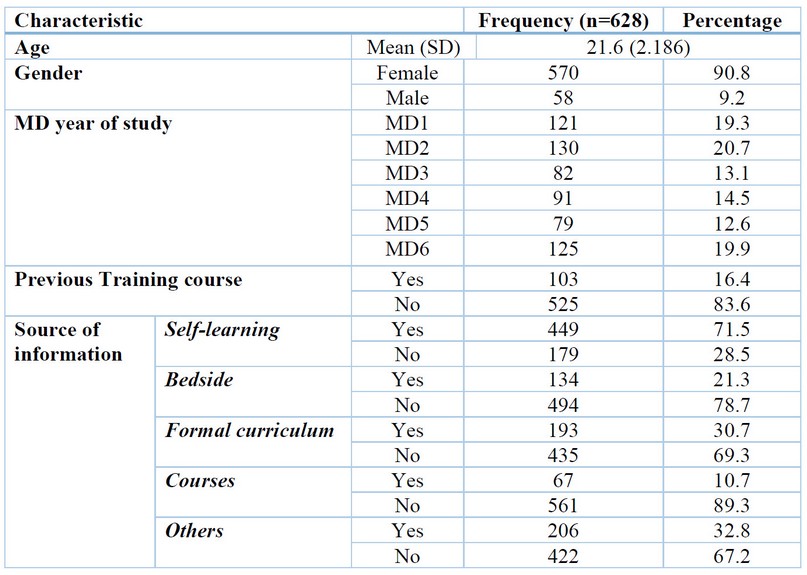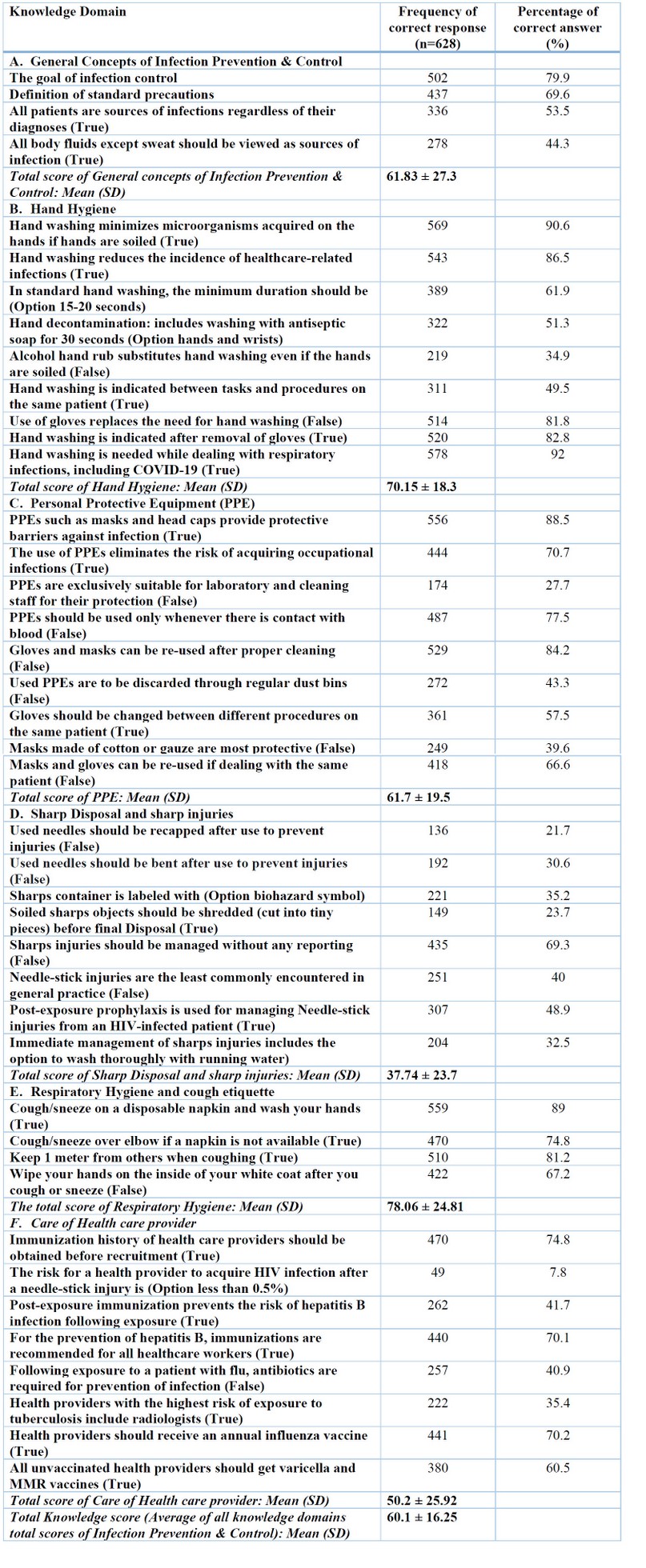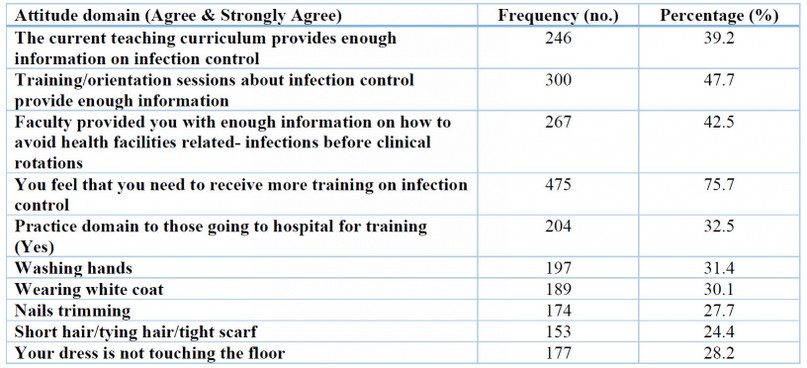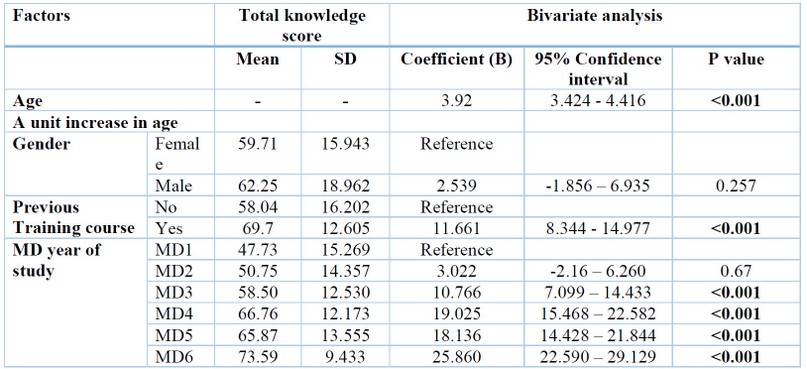2023.08.03.105
Files > Volume 8 > Vol 8 No 3 2023
Awareness and attitude on infection prevention and control among medical students in Oman
1 Assistant professor, National University of Science and Technology, College of Medicine and Health Sciences, Oman; [email protected].
2 Professor, National University of Science and Technology, College of Medicine and Health Sciences;Oman; [email protected].
3 Assistant professor, National University of Science and Technology, College of Medicine and Health Sciences, Oman; [email protected].
4 Subinternship student, National University of Science and Technology, College of Medicine and Health Sciences, Oman; [email protected].
* Corresponding Author: [email protected].
Available from: http://dx.doi.org/10.21931/RB/2023.08.03.105
ABSTRACT
Knowledge and awareness of infection prevention and control measures among medical students must be adequate and optimum. We evaluate medical students' understanding, knowledge, and attitude toward infection prevention and control. This cross-sectional study targets medical students at the College of Medicine, Oman. An adapted questionnaire was used to measure students' characteristics, concepts of infection prevention and control, hand hygiene, respiratory hygiene, cough etiquette, personal protective equipment, sharp instrument injuries and care of health care providers. The questionnaire explored the attitude and practice of infection prevention and control among medical students. A total of 628 medical students were included in the study. The majority were females (90.8%). A knowledge score on infection prevention and control was 61.83%. The hand hygiene knowledge score was higher (70.15%) than the general concept. The personal protective equipment knowledge score was 61.7%. Sharp injuries knowledge score was the lowest compared to other domains (37.74%). Respiratory hygiene and cough etiquette knowledge score was highest among all domains (78.05%). Care of health care providers had a lower total score of 50.2%. The knowledge of medical students on infection prevention and control was average. Proper training programs are required to protect medical students and their patients.
Keywords: control; infection; Oman; prevention; students
INTRODUCTION
Infection prevention and control is a standard measure utilized by healthcare providers to minimize the risk of transmission of infectious diseases among patients and themselves.1
Healthcare-associated infections are significant health problems that increase both morbidity and mortality.2 Furthermore, it increases the health care costs in developed and developing countries.3
Healthcare-associated infections are also associated with increased length of hospitalization and the development of multidrug-resistant bacteria.4
It has been estimated that one out of 20 hospitalized patients will encounter healthcare-associated infections; such risk is substantial for patients and healthcare providers, including medical students.5 Results from previous research in Middle Eastern countries showed a need for more knowledge among healthcare professional students about infection prevention and control.6-8
Subsequently, all medical students must acquire knowledge and skills related to infection prevention and control through its incorporation into their training /orientation program.9
Thus, this study was planned with the objectives of evaluating medical students' awareness (perception of a situation), knowledge (information acquired through education), and attitude (settled ways of thinking and perception) toward infection prevention and control, including standard precautions, hand hygiene, respiratory hygiene and cough etiquette, and use of Personal Protective Equipment (PPE), knowledge about sharps disposal and injuries, and care of health care providers. In addition, the study also aimed at exploring their prospects toward the current curriculum/training in providing them with adequate information and skills about infection prevention and control programs.
MATERIALS AND METHODS
A cross-sectional study was conducted in the College of Medicine and Health Sciences (COMHS), National University (NU), Suhar, to assess medical students' knowledge, attitude, and practice about infection prevention and control measures. Data was collected in January, February, and March 2022 after getting approval from the Research and Ethics Committee. We included all the medical students of COMHS from the first year (MD1) to the final year (MD6); thus, no sample size was calculated. Informed consent was taken from the students, and their participation was voluntary; data anonymity and confidentiality were maintained.
A structured pretested questionnaire adapted from available literature (Amin et al.),10 was used to collect data from all the medical students from MD1 to MD6 who gave informed consent to participate in the study. The questionnaire was pilot-tested with a few students before the data collection to verify the validity of the content, grammar, and language use. Independent variables were demographic characteristics of students like age, gender, year of study, source of information on infection prevention and control and previous training on infection control. The dependent variable was the total knowledge score of all subsets. Knowledge score had further subsets as the overall concept of infection prevention and control, hand hygiene, respiratory hygiene, cough etiquette, personal protective equipment, sharp instrument injuries and care of health care providers. The questionnaire had closed-ended questions on all these domains in the form of True / False / I do not know or choosing one correct option. Similar questions were addressed to ascertain the attitude and practice of students related to infection control. Data was filled by the students in person in the college.
Data entry and analysis were done in SPSS version 22. After data entry, thorough data cleaning was carried out; incomplete responses in 2 or more items were discarded. Descriptive statistics was used to summarize demographic variables in frequency and percentage for categorical variables and mean and standard deviation for continuous variables. In the knowledge questionnaire, correct responses were given a score of 1 and incorrect answers were assigned a score of zero. Each Section of the knowledge domain was calculated as a percentage score, and an overall knowledge percentage score was also calculated for all the questions in all sections. T-test and ANOVA were used for testing mean differences. Bivariate analysis using linear regression was deployed to find the association of the total knowledge score with the studied independent variables. It was represented by the beta coefficient, 95% confidence interval and p-value. A p-value of less than 0.05 was considered statistically significant for all statistical testing.
RESULTS
Demographic characteristics
There were 628 participants in the study. The mean age of participants was 21.6 years ± 2.186. Most participants were females (90.8%), and only 9.2% were male students. Most participant students were from MD2, followed by MD6 and MD1. Only a few (16.4%) had attended any previous infection prevention and control training courses. Regarding the source of information, most of the students got information from self-learning (71.5%), 30.7% from formal curriculum teaching and 21.3% from bedside teaching. [Table 1]

Table 1. Demographic characteristics of participants
Knowledge of students on infection prevention and control
All the students' knowledge of Section A, the general concept of infection prevention and control, showed a total score of 61.83%, out of which the maximum knew the goal of infection prevention and control (79.9%). The least was on the subset "source of infection as all body fluids except sweat" (44.3%). Regarding knowledge in Section B: Hand hygiene, the total knowledge score was higher (70.15%) than the general concept of Section A. In this Section, the most minor subset, known as "alcohol hand rub substitutes hand washing even if hands are soiled; a false statement" (34.9%), followed by "Hand washing is indicated between tasks and procedures on the same patient (True)" (49.5%). The rest of the other subsets of handwashing had a good knowledge score.
Regarding knowledge of Section C: PPE, the total score for all the components was 61.7%. The least known subset was "PPEs are exclusively suitable to laboratory and cleaning staff for their protection (False)" (27.7%), followed by "Hand washing is indicated between tasks and procedures on the same patient (True)" (39.6%). The other components of this knowledge domain had a good amount of knowledge. In Section D on Sharp Disposal and Sharp Injuries, the total score was the lowest compared to other knowledge domains (37.74%). Students had poor knowledge of "Used needles should be recapped after use to prevent injuries (False)" (21.7%) and "Soiled sharps objects should be shredded (cut into tiny pieces) before final disposal (True)" (23.7%). Other subsets of knowledge could have been better in this Section. In Section E on respiratory hygiene and cough etiquette, the total knowledge score was the highest among all sections, with 78.05%. All the subsets of this Section had good knowledge scores for all the students. The lowest score in this Section was "Wipe your hands on the inside of your white coat after you cough or sneeze (False)" (67.2%). In Section F on Care of health care providers, they had a lower total score of 50.2%. The minimum subset scored in this Section was "The risk for a health provider to acquire HIV infection after a needle-stick injury is (Option less than 0.5%)" (7.8%). The maximum score subset was 74.8% on "Immunization history of health care providers should be obtained before recruitment." [Table 2]

Table 2. Knowledge of infection prevention and control
The overall total score combining the averages of all sections of the knowledge domain (Section A to Section F) was 60.1%, which shows that students' knowledge of infection prevention and control was average and not very good. Further, the students' attitudes on training in infection prevention and control were assessed by questions using a Likert scale. Most students agreed (75.7%) that they need more infection prevention and control training. Even though students' knowledge of infection prevention and control was average, when questioned about their hospital practice, they needed a better response to practicing the optimal measures. [Table 3]

Table 3. Attitude and practice of infection prevention and control
Factors associated with total knowledge score
Different demographic factors were considered to find an association between them and the knowledge score. On Bivariate analysis, it was found that the knowledge had a significant association with age; Pearson correlation coefficient r=0.527 (p<0.001). With every unit increase in age, the knowledge score increased by 3.92. When gender was compared with total knowledge score, it was found that males had a higher mean score of 62.25 compared to females, 59.7%, but this difference was not statistically significant; t (626)=1.134, p=0.257. Those with previous training on infection prevention and control had a higher knowledge score of 69.7 than those without training (58.04), and this difference was statistically significant t (626)=6.904, p <0.001. When questioned on different sources of information, it was found that through bedside information received in clinical years, the mean total score was better (67.18±14.720) than those who did not receive it (57.99±16.097); t (626)=5.96, p<0.001. Similarly, those who got information through formal curriculum had a higher mean total score (64.99±13.409) than those who did not have it (57.71±16.893); t (626)=5.294, p<0.001.
Knowledge scores of different MD years were compared, and it was found that clinical years MD4, MD5, and MD6 had higher knowledge scores than premed and preclinical years. Adjusted for Bonferroni correction, 1-way ANOVA shows significant results when comparing MD1 to MD6; F (5,270)=69.8, p<0.001. Further in Linear regression, it was found that MD6 (Coefficient=25.8 CI=22.5 to 29.1, p<0.001), MD5 (Coefficient =18.1, CI=14.4 to 21.8, p<0.001) and MD4 (Coefficient=19, CI=15.4 to 22.5, p<0.001) where students are going to hospitals has highly statistically significant total score of knowledge. [Table 4]

Table 4. Factors associated with knowledge score
DISCUSSION
Infection prevention and control are crucial for the safety of both healthcare workers and patients. Health professional students need to have adequate knowledge about infection prevention and control to reduce the risk of transmission of infection among them and the patients while learning and training.7 Consequently, we assessed medical students' knowledge, attitude, and practice regarding infection control measures in this study.
In this study, we found that clinical years (MD4, MD5 and MD6) had higher infection prevention and control knowledge scores than preclinical (MD3) and premed (MD1 and MD2) years. This finding is consistent with Khubrani et al.,7 Nalunkuma et al.,11 and Silva et al. studies.12 This can be related to the less clinical exposure at the beginning of the MD program and to the curriculum point of view.
Regarding the knowledge of hand hygiene, most of the students demonstrated good ability. However, they needed to learn about hand washing versus alcohol use, hand washing between tasks and the standard hand washing time. It compares to Hammerschmidt et al. study that, showed higher knowledge of hand hygiene and normal hand washing time.13 This can imply increased risks of transmission of infection between patients by medical students.
In this study, more than half of the medical students gave a wrong answer that "All body fluids except sweat should be viewed as sources of infection," which was consistent with the Khubrani et al. study, and this reflects inadequate knowledge about body fluids being one of the mode transmissions of infection between and patients and medical students.7
Most medical students (n=556, 88.5%) in our study know the importance of PPE, such as masks and head caps, in providing protective barriers against infection. However, other related knowledge of PPE, such as "discarding the PPE bins" and "types' of protective masks," is poor. This finding is consistent with Khubrani et al.,7 Nalunkuma et al.,11 and Tavolacci et al. studies.14 Such inadequate knowledge of PPE can increase the risk of spreading infections between patients.
Regarding the knowledge of our medical students about sharp Disposal and sharp injuries, we found that it represents the lowest level of knowledge, which is also consistent with Khubrani et al.,7 Nalunkuma et al.,11 and Tavolacci et al. studies.14 These finding necessitates improving knowledge of handling sharp objects to minimize the risk and complication of such sharp injuries.
The good respondents among the medical students in our study to respiratory hygiene and cough etiquette could be because of the COVID-19 pandemic that emphasizes these measures. This finding is similarly seen in other studies.15,16
Most of our medical students agreed (75.7%) that they need more infection prevention and control training. Even though students' knowledge of infection prevention and control was average, when questioned about their hospital practice, they had poor responses to practicing the optimal measures.
CONCLUSIONS AND RECOMMENDATIONS
The average total knowledge score on infection prevention and control of students was 60%. The maximum knowledge of the students was on respiratory hygiene and cough etiquette (78%), followed by hand hygiene (70%). More emphasis must be given to topics like personal protective equipment, sharp Disposal, and care of health care providers. Age, previous infection control training, clinical years, and late preclinical years had statistically significant higher total knowledge scores (p<0.001). Formal curriculum and bedside teaching impart better knowledge than self-learning as it requires hospital visits and observing practical skills.
More sessions should be taken on infection prevention and control for students in the early years of the medical program. They should be built within the curriculum as training courses for preclinical years and hospital bedside exposure in clinical years.
Funding Sources: The authors received no financial support for this article's research, authorship, and publication.
Conflict of Interest: The author(s) declares no conflict of interest.
REFERENCES
1. Punia S, Nair S, Shetty RS. Health Care Workers and Standard Precautions: Perceptions and Determinants of Compliance in the Emergency and Trauma Triage of a Tertiary Care Hospital in South India. Int Sch Res Notices. 2014 Oct 29;2014:685072. Doi: 10.1155/2014/685072.
2. Banach DB, Bearman GM, Morgan DJ, Munoz-Price LS. Infection control precautions for visitors to healthcare facilities. Expert Rev Anti Infect Ther. 2015;13(9):1047-50. doi: 10.1586/14787210.2015.1068119.
3. Ruis AR, Shaffer DW, Shirley DK, Safdar N. Teaching health care workers to adopt a systems perspective for improved control and prevention of healthcare-associated infections. Am J Infect Control. 2016 Nov 1;44(11):1360-1364. doi: 10.1016/j.ajic.2016.04.211.
4. Ibrahim AA, Elshafie SS. Knowledge, awareness, and attitude regarding infection prevention and control among medical students: a call for educational intervention. Adv Med Educ Pract. 2016 Aug 22;7:505-10. Doi: 10.2147/AMEP.S109830.
5. Ayub A, Goyal A, Kotwal A, Kulkarni A, Kotwal A, Mahen A. Infection control practices in health care: Teaching and learning requirements of medical undergraduates. Med J Armed Forces India. 2013 Apr;69(2):107-12. doi: 10.1016/j.mjafi.2012.07.021.
6. AL-Rawajfah OM, Tubaishat A. Nursing students' knowledge and practices of standard precautions: A Jordanian web-based survey. Nurse Educ Today. 2015 Dec;35(12):1175-80. doi: 10.1016/j.nedt.2015.05.011.
7. Khubrani A, Albesher M, Alkahtani A, Alamri F, Alshamrani M, Masuadi E. Knowledge and information sources on standard precautions and infection control of health sciences students at King Saud bin Abdulaziz University for Health Sciences, Saudi Arabia, Riyadh. J Infect Public Health. 2018 Jul-Aug;11(4):546-549. doi: 10.1016/j.jiph.2017.10.013.
8. Nasiri A, Balouchi A, Rezaie-Keikhaie K, Bouya S, Sheyback M, Rawajfah OA. Knowledge, attitude, practice, and clinical recommendation toward infection control and prevention standards among nurses: A systematic review. Am J Infect Control. 2019 Jul;47(7):827-833. doi: 10.1016/j.ajic.2018.11.022.
9. Vincent JL. Nosocomial infections in adult intensive-care units. Lancet. 2003 Jun 14;361(9374):2068-77. doi: 10.1016/S0140-6736(03)13644-6.
10. Amin TT, Al Noaim KI, Bu Saad MA, Al Malhm TA, Al Mulhim AA, Al Awas MA. Standard precautions and infection control, medical students' knowledge and behavior at a Saudi university: the need for change. Glob J Health Sci. 2013 Apr 21;5(4):114-25. doi: 10.5539/gjhs.v5n4p114.
11. Nalunkuma R, Nkalubo J, Abila DB. Knowledge of Infection Prevention and Control and associated factors among undergraduate health professional students at Makerere University College of Health Sciences, Uganda. PLoS One. 2021 Aug 10;16(8):e0255984. doi: 10.1371/journal.pone.0255984.
12. Silva O, Palomino S, Robles A, Ríos J, Mayta-Tovalino F. Knowledge, Attitudes, and Practices on Infection Control Measures in Stomatology Students in Lima, Peru. J Environ Public Health. 2018 Sep 12;2018:8027130. Doi: 10.1155/2018/8027130.
13. Hammerschmidt J, Manser T. Nurses' knowledge, behavior and compliance concerning hand hygiene in nursing homes: a cross-sectional mixed-methods study. BMC Health Serv Res. 2019 Aug 5;19(1):547. doi: 10.1186/s12913-019-4347-z.
14. Tavolacci MP, Ladner J, Bailly L, Merle V, Pitrou I, Czernichow P. Prevention of nosocomial infection and standard precautions: knowledge and source of information among healthcare students. Infect Control Hosp Epidemiol. 2008 Jul;29(7):642-7. doi: 10.1086/588683.
15. Zenbaba D, Sahiledengle B, Bogale D. Practices of Healthcare Workers regarding Infection Prevention in Bale Zone Hospitals, Southeast Ethiopia. Advances in Public Health. 2020 Feb;2020:1-7. doi:10.1155/2020/4198081.
16. Huh. S. How to train health personnel to protect themselves from SARS-CoV-2 (novel coronavirus) infection when caring for a patient or suspected case. J Educ Eval Health Prof. 2020;17:10. doi:10.3352/jeehp.2020.17.10.
Received: 25 June 2023/ Accepted: 26 August 2023 / Published:15 September 2023
Citation: Al Rudaini M, Anwar S , Al Mutori H , Ghaith A..Awareness and attitude on infection prevention and control among medical students in Oman. Revis Bionatura 2023;8 (3) 105 http://dx.doi.org/10.21931/RB/2023.08.03.105
